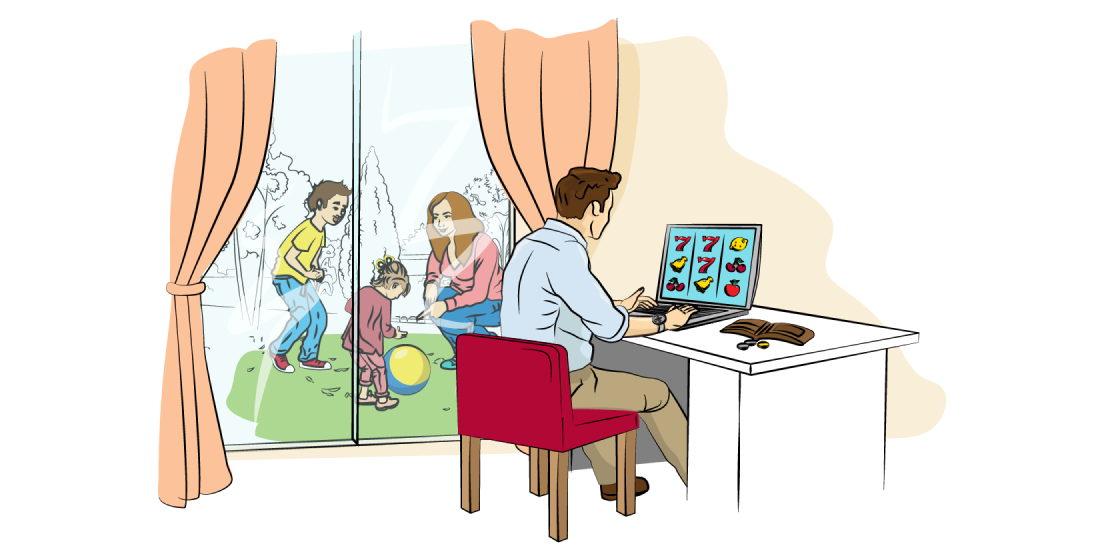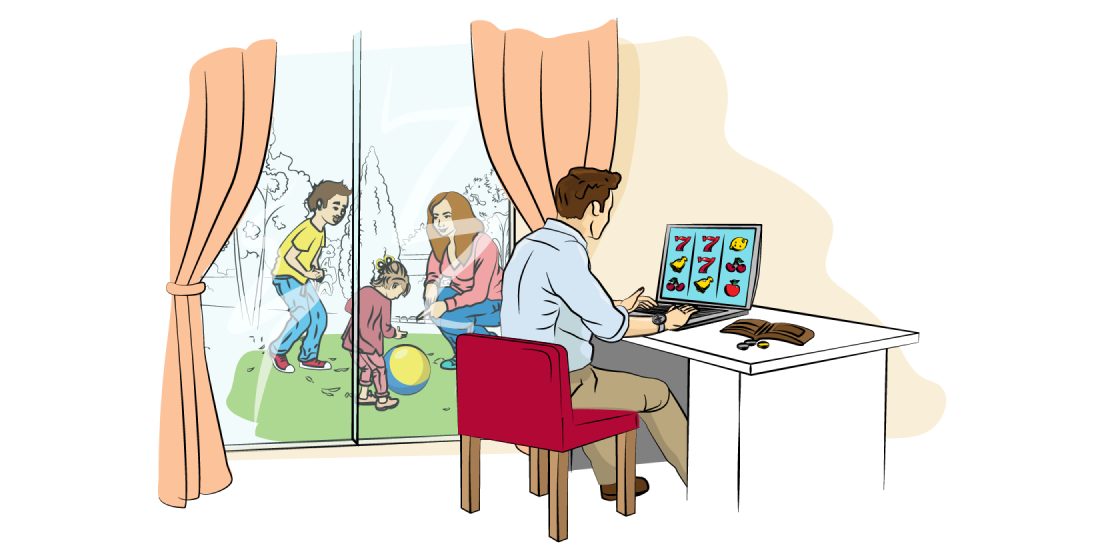What Makes Gambling Addictive and How Problem Gambling Develops
Gambling has many sides. On one hand, it can be a fun form of entertainment, while, on the other hand, it can develop into a serious addiction. Some people can enjoy gambling on a casual and healthy level, but others may get hopelessly addicted and are unable to stop.
In this article, we explore the addictive nature of gambling, what causes gambling addiction to develop, and why some people are more susceptible to it than others.
Table of contents:
- Types of gamblers
- Is it about money?
- Causes of gambling addiction
- How game design contributes to gambling addiction
Types of gamblers and the risk of developing a gambling problem
Why can some people enjoy gambling as a harmless form of entertainment, but for others it develops into a dangerous addiction? This can in part be explained by the fact that different people experience gambling in different ways. Robert L. Custer, M.D., one of the pioneers behind pathological gambling treatments, identified six types of gamblers.
- Professional gamblers
- Antisocial/personality gamblers
- Casual social gamblers
- Serious social gamblers
- Relief and escape gamblers
- Compulsive gamblers
Each group has its own reason for partaking in gambling, which directly influences how likely a person is to develop a gambling addiction.
1. Professional gamblers
For professional gamblers, gambling is not an activity that they do for fun or enjoyment. Gambling is their profession, as well as their main source of income. This type of player is not very common in online casino games against the house, as these are configured to favor the casino and to give it an advantage. However, players who professionally abuse casino bonuses or count cards in blackjack could be a relevant subcategory of the professional gambler type.
Professional gamblers have low odds of developing a gambling addiction. They gamble in a logical and systematical way with a clear plan and strategy. Their reasons for gambling are also very different from those of a casual gambler.
2. Antisocial/personality gamblers
Much like professional gamblers, antisocial/personality gamblers also view gambling as a way of making money. However, unlike their professional counterparts, these gamblers tend to use illegal practices to make a profit. These players look for ways to gain an advantage over the house and are not afraid of breaking the law to achieve this goal. They use practices such as fixing matches in sports betting, using marked cards in table games, etc.
Antisocial/personality gamblers do not usually develop gambling addictions. But they may use gambling addiction as an excuse if their illegal activities put them in a problematic situation.
3. Casual social gamblers
Casual social gamblers view gambling as a form of entertainment. They often participate in gambling-related activities with their friends, use gambling to socialize, distract themselves from their everyday lives and even to relax.
Gambling does not have a particularly negative impact on this kind of player. Their families, social and work lives go largely unaffected by this pastime. In comparison to other types of gamblers, casual social gamblers have a balanced and healthy attitude towards gambling.
4. Serious social gamblers
As indicated by the name of this type of player, serious social gamblers are very much akin to their "non-serious" casual counterparts but are much more dedicated. Gambling is one of the most prevalent types of entertainment and one of the most common ways for serious social gamblers to spend their time. But it is still lower on the ladder of priorities than family, friends, career, etc. They can control their gambling habits.
5. Relief and escape gamblers
Whereas casual and serious social gamblers play to entertain themselves, relief and escape gamblers use gambling to block out the negativity of their lives. This can be anything, including feelings of boredom, loneliness, anger or depression. If a player’s mental state gets worse but they have no healthy way of dealing with these negative thoughts and emotions, their gambling habits are likely to get worse too. In the worst-case scenario, they could get addicted.
6. Compulsive gamblers
Compulsive gamblers (also known as problem gamblers or gambling addicts) no longer have control over their gambling habits. Gambling is the most important thing in their lives, and they are willing to pay any price and make any sacrifice to play even more. Gambling has an extremely negative effect on them.
In the following parts of this article we specifically focus on this type of gamblers - compulsive gamblers, problem gamblers, gambling addicts.
Is it just about the money?
In short, no, it is not. When people first researched gambling addiction, some argued that money could be the main source of motivation for a problem gambler. Over time, studies would show that this wasn’t the case at all. And the misconception that addicted people are obsessed with a vision of immense wealth and a lavish lifestyle is not only incorrect, but harmful to suffering individuals as well.
This is not to say that money does not play a very important role in the life of someone with problematic gambling habits, but it is not the source of their unfortunate addiction either. We address the causes behind gambling addiction in the subsequent sections on biological factors and psychological factors, respectively.
The financial cycle of a problem gambler
But before that, we look into how problematic gambling habits affect financial wellbeing. The following widely accepted financial cycle of a problem gambler was proposed by Dr. Henry Lesieur. If you notice any of the mentioned tendencies in yourself, read our article on problem gambling diagnosis and symptoms to make sure that you are not developing any potentially harmful habits.
It is important to note that this financial cycle is called a "cycle" for a reason. It can also be seen as a spiral that repeats itself forever, but each repetition puts the suffering player into increasingly worse life situations until they eventually hit rock bottom. The cycle can be broken, however, ideally through the affected person seeking help for their gambling addiction, but, if not addressed in a proper and timely fashion, it could lead to being unable to gamble anymore due to loss of disposable income, or even worse, death.
1. The abundance of finances as a gambling enabler
In the beginning, the player has enough money to indulge in gambling as much as they like. Their bets tend to be at their highest at this point. This is especially dangerous for people who have built up a "resistance" against lower bets and can no longer get the same thrill out of them. A person suffering from a severe case of gambling addiction can easily burn through the majority of their monthly disposable income in a matter of days, sometimes even hours, while chasing a "high".
2. The decrease in finances as a gambling inhibitor
Sooner or later, the problem gambler begins to run short of money, although they are not completely broke yet. Feelings of anxiety, regret and melancholy are very common at this stage of the cycle. The concept of "chasing losses" also rears its ugly head at this point. Addicted players may feel compelled to win back what they have lost, but this is highly unlikely to work in their favor and usually results in more money being lost.
3. Lack of finances as a source of debt and existential distress
This part of the cycle occurs once the addicted player completely runs out of money. The feelings of anxiety and melancholy understandably turn into utter desperation and sometimes even depression. Depending on the severity of the addiction and their willpower, the gambler may be able to quit completely for a limited time. However, this can become increasingly difficult to do so, as really serious problem gamblers can even experience withdrawals when not playing as if suffering from substance dependency.
The cycle ends and resets when the player comes across some more money. This money can come from vastly different sources, the least harmful from their paycheck, and in order of increasing concern, by borrowing from their family, friends, banks, loan sharks or through some form of illegal activity.
What causes and perpetuates gambling addiction?
When it comes to addictions, it is important to understand that they are never caused by a single factor. They are a combination of inter-related factors that create a complex array of triggers, compulsions and desires, resulting in the problematic behavior. These factors can be separated by origin into the following groups: biology, psychology, social and spiritual influence. This concept is also known as the Bio-Psycho-Social-Spiritual Model of Addiction.
For gambling addiction, we are going to focus on the first two types of factors: biological and psychological. These are supported by concrete evidence and can be blamed for the majority of problem gambling cases. By lifting the curtain on some of the background concepts of this illness, we aim to break down longstanding misconceptions and bring more understanding and compassion into the conversation.
Biological factors
Some have defined addiction as a "chronic disease of the brain". But this definition is a bit too simple. It might also seem to a problem gambler that they can’t do anything about their addiction because they are "sick". This is of course completely incorrect. But this definition does a very good job of giving us several interesting insights.
Firstly, approximately 50% of addiction is based on personal biology. Secondly, the idea that people get addicted to substances and activities is technically untrue. In reality, they become addicted to the chemicals that their brains secrete in response to outside stimuli. Thirdly, people with healthy brains are more likely to develop an addiction. Human brains are "programmed" to compel us to repeat pleasurable activities and experiences. These are things that help us survive, such as eating, drinking and making babies. Psychology and biology experts call these actions "motivated behaviors".
However, the brain can adapt to new stimuli and begin evaluating them as equally important, if not more so, than the ones mentioned before. This is the biological process through which a person develops an addiction. As the addiction progresses, it further impacts the brain and even makes physical changes to its structure. In total, there are six main offenders in this process.
Three parts of the brain:
- Cerebral Cortex
- Amygdala
- Hypothalamus
Three chemicals in the brain:
- Serotonin
- Dopamine
- Norepinephrine
Cerebral Cortex
Changes in the cerebral cortex result in impaired decision-making skills and rising tendencies towards impulsivity and compulsive behavior. These changes are the reason why an addicted person can experience difficulties in making smart and healthy decisions. Instead, they may decide to act in risky and unhealthy ways on a whim.
Amygdala
The amygdala is associated with memories and emotions. Positive and negative memories create associations that help the brain anticipate what is yet to come. Take for example a player that gambles every Wednesday after leaving work and grabs a bite to eat at their favorite restaurant. Their brain expects this behavior to repeat every week and, in turn, a habit is formed.
But if that player decides to stop gambling and continues to repeat their routine minus the gambling, they experience withdrawal symptoms as the brain expects a surge of good feelings. This is why gambling can eventually cause a person to relapse if the routines and habits associated with it are not halted too.
The Hypothalamus
The hypothalamus is closely related to the ability to deal with stress. Many gamblers, both problematic and non-problematic, use gambling as a coping mechanism to escape stressful situations. Unfortunately, addiction lowers the ability to effectively reduce stress levels. This forms a vicious cycle in which an addicted player seeks gambling to cope with stress levels. Over-indulgence in gambling tends to land players in difficult situations, creating further stress. But if gambling habits are interrupted, subsequent withdrawals cause even more stress.
Serotonin
Serotonin, as opposed to dopamine, is considered to be the true "happy chemical". Low levels of serotonin cause melancholy and even depression. People suffering from addiction seem to be particularly prone to mood swings. Serotonin is also tied to motivation and motivated behaviors (e.g. eating, drinking, etc.). Problem gamblers seem to demonstrate abnormalities in flows and levels of serotonin, which can cause problems with motivated behaviors (e.g., missing out on dinner and staying up all night to gamble even more).
Interestingly, serotonin has also been heavily linked to "chasing losses", a tendency that can be found everywhere in the world in every kind of gambler. Serotonin and dopamine seem to make players less sensitive to the "turn-off" of losing. After suffering a losing streak, the average person quits in disgust. On the other hand, a gambler who has become desensitized to the negative feelings associated with losing money, will continue chasing for much longer.
Dopamine
Dopamine is very closely related to the processes associated with the amygdala part of the brain. Contrary to popular belief, dopamine is not a "happy chemical", but instead governs our brain’s reward systems. Carrying out an action deemed as "desirable" releases dopamine. This surge of chemicals is often experienced as a blissful "high" feeling, which is why people feel compelled to repeat this behavior. While gambling, both recreational and problem gamblers were observed to have higher dopamine levels than normal.
Norepinephrine (Noradrenaline)
Norepinephrine is a chemical that prepares and motivates the body and the brain for action. It increases alertness and arousal, promotes vigilance and helps with the storage and subsequent recall of memories. It also causes restlessness and stress. Naturally, the highest levels are experienced in dangerous situations, when the fight-or-flight instinct kicks in.
Interestingly, both problem gamblers and non-problem gamblers seem to experience higher levels of norepinephrine when gambling. This could be why so many players become completely immersed and lost while gambling. Additionally, the chemical has been tied to relapses, reward sensitization (where a person gets progressively more excited by the same thing), attention and sensation seeking.
Psychological factors
As already mentioned, addiction is a complex system of inter-related factors called the Bio-Psycho-Social-Spiritual Model of Addiction. But this rabbit hole goes deeper. Each factor has its subdivisions and approaches. This applies to the psychological aspects of addiction as well.
Specialists have tried to find a single psychological approach that explains gambling addiction in a straightforward way but have ultimately come out empty-handed. The best and most widely accepted theory is an "integrated model" proposed by addiction psychologists Blaszczynski and Nower.
The integrated model acknowledges the applicable truths from separate psychological theories (learning, cognitive, addiction, personality and psycho-analytic) and connects the dots between them to create a comprehensive theory of the discussed topic. In this case, Blazczynski and Nower break up problem gamblers into three different categories based on the potential reasoning behind their addiction:
- Emotionally vulnerable gamblers
- Behaviorally conditioned gamblers
- Biologically based gamblers
The theory accepts that all problem gamblers show similar symptoms of unhealthy habits, but the main origin of these tendencies is very different. Nonetheless, researchers point out that multiple aspects, such as environmental factors, the central role of player arousal, conditioning (learning processes that cause a person to react to something in a specific way, such as feeling a strong desire to play slots as soon as its music is heard), and cognitive distortions (illusions), appear in all three categories.
Emotionally vulnerable gamblers
Emotionally vulnerable gamblers play for the sake of escapism and to get a break from the negativity of their lives. This type of compulsive gambler is typically emotionally disturbed, has poor coping skills, is socially isolated and has low self-esteem. The best way to help them is through counselling and treatment of underlying emotional damage, as well helping them create healthier coping skills.
Behaviorally conditioned gamblers
This type of gambler is caught up in their compulsions and behaviors. They are very susceptible to environmental triggers and tend to repeat the same series of actions. Consultations with trained professionals are usually the best way of breaking them out of these behavioral patterns.
Biologically-based gamblers
These players are a victim of their biological "wiring". Genetic and neurochemical factors result in near-constant need for stimulation and impulsive actions. Medication, along with therapy, can help gamblers stop being slaves to their bodies and help them to make their own decisions.
How game design contributes to gambling addiction
Casinos, in general, have a very clear set of goals. The objective of all land-based and online casinos is to keep gamblers playing and spending as much money as possible. Ideally, gamblers walk away with a good feeling and want to do it all over again. This is known as "expediting gambling productivity". In reality, this means "increasing the number of bets made by a player in a given time".
Land-based casinos have a clear advantage compared to their online counterparts. Thanks to players being physically present, the casino has more ways to influence them through staff, casino layout and decorations. But online casinos also have special techniques for getting into your head.
Let’s look at and discuss the different techniques game designers use to glue us to our mobile and laptop screens to part us with our hard-earned money.
1) Tokenization
Tokenization is when you exchange currency for something else that represents it. Just imagine your run-of-the-mill poker chip. This technique is used in many online and most real-life casinos because it creates a kind of "mental distance" in understanding the chip’s real value. This makes it much easier to bet and spend your chips without thinking about how much money you are actually spending.
2) Gamification
As the name suggests, gamification techniques take their inspiration from gambling’s younger cousin, video games. Gamification techniques can take a variety of shapes and forms. Some online casinos have leaderboards to motivate players to compete for the top spots, to take bigger risks and to play even more. Other techniques include more skill-based games that create the feeling of being an expert, to boost feelings of achievement and satisfaction.
3) Easy access to different gaming opportunities
The concept is quite simple. Ideally, a player has easy access to many different games and game types without having to click on another tab or site. People become naturally comfortable to the point of laziness, where even a small inconvenience like clicking a different page could make them less likely to continue playing.
4) Reward uncertainty
Also known as "variable intermittent ratio uncertainty", this technique was developed based on the theories of B.F. Skinner (the famous creator of the Skinner Box, which he even compared to a slot machine). His research showed that people experience stronger reactions when they are unsure whether or not they will win. Waiting for a result creates suspense, which is released only after seeing the result.
Later on, the gambling industry realized that it could motivate gamblers to play more and faster through frequent near misses and small wins. A person who feels really close to that "big win" is much less likely to stop playing.
5) Losses disguised as wins
Also known as "fake wins", losses disguised as wins are most prevalent in slot machines with a high number of winlines or ways to win. Many slots have 25, 50 or even hundreds of thousands of win lines, making it more likely to get a "winning" combination.
The psychology behind this concept is that you will win more often due to there being more opportunities to win. Of course, players want to win all the time. You therefore bet more and continue playing because you feel like you are making money. But the wins you get on these machines are often lower than the bets you actually put in. The casino is still taking all of your money but doing it slowly without you even realizing it.
6) Audio-visual positive reinforcement
Bright dazzling lights and loud crisp sound effects have been an inseparable part of gambling for as long as most of us can remember. But not many people realize that they are designed to keep your attention after it has already been caught.
There is a surprising amount of thought that goes into creating a suitable audio-visual experience. The sound has to be just loud enough to drown out your surroundings, but not loud enough to be distracting. It has to correspond to the things that are happening in front of you. This gives players a feeling that their actions matter and that they are directly influencing the game in some way. The same goes for the on-screen visuals. They have to be bright and eye-catching but at a level that does not interfere with play. Just something to look at while you zone out…
7) Zone-inducing features
When discussing what causes and perpetuates gambling addiction, we mentioned that addiction is often a coping mechanism gone wrong when used to escape negative emotions. "The Zone", first defined by researcher Natasha Schüll, is key to understanding this behavior.
"The Zone", also known as "the gambler’s high", is a state of mind when a player becomes completely immersed in the game. They lose track of time, sometimes spending hours until something distracts them and breaks their "trance".
Two major components have already been discussed that cause gamblers to slip into the Zone: sound effects and visuals. But there is a third aspect that game designers should think about when creating games to zone out to. Speed of play is the most important aspect. If gameplay is too slow, players gets bored. If it is too fast, players get frustrated. Game designers have therefore begun to program their games to adapt to speed preferred by players.
However, there is a feature that gets rid of these considerations altogether. Auto-play is nothing new on the gambling market. It has become ingrained into gambling culture and no one bats an eye at it anymore. But what people don’t realize is that it can be quite dangerous under certain circumstances. After pressing auto-play, you don’t even have to play anymore. The game plays itself and, as it does, you might not realize how much time you’ve played, how much money you’ve spent or even how long you’ve been playing.
Conclusion
Gambling addiction is much more complex than most people give it credit for. Its combination of biological and psychological factors creates a difficult foe to compete against. If you suspect that you or a loved one is at risk of becoming addicted, we highly recommend our article on problem gambling symptoms and diagnosis. If you know of anyone who is already struggling with bad gambling habits, please suggest our article on how to overcome problem gambling or our list of problem gambling help centers.

















